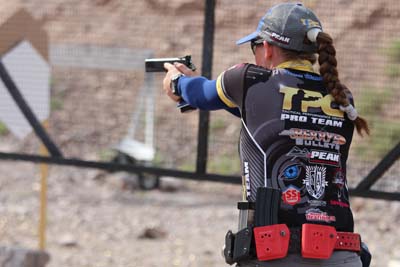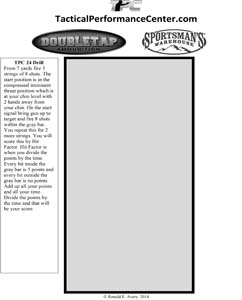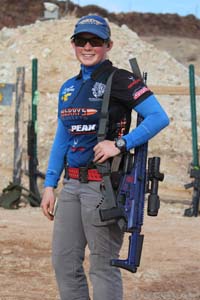![]() Dry-Fire Training and Utilizing a Timer
Dry-Fire Training and Utilizing a Timer
Whether you shoot in competition, conceal carry, law enforcement, military, etc., you should dry-fire. Dry-fire is a great way to practice without spending a lot of money on ammunition. There are many skills that can be learned and perfected in dry-fire. People tend to steer away from dry-fire because it is boring. It can also tire you out easily. But, if you keep with it for a couple days, weeks, months or years, you will see the improvement in your shooting.
When dry firing, you want to maintain and grow your fundamentals. Without fundamentals, the entire shooting platform would fall apart. Thus, the fundamentals are a necessity in order to shoot faster, more accurately, and with a greater certainty of a hit. The fundamentals include the Fire Control Triangle and the Reactive Shoot Cycle. Both are needed to fulfill the needs of the fundamentals.
The Fire Control Triangle (FCT), has three parts; the stance, grip, and trigger control. The FCT starts with the stance. To achieve the ultimate stance, you must put your center of gravity forward, skeletal alignment, relaxation and isolation of tension and natural point of aim. The grip must minimize the leverage of the gun, maximize the friction on the gun and increase bio-mechanical efficiency. The trigger control just needs to pull the trigger straight back and fire the gun within an acceptable disturbance of the sight picture.
 The Reactive Shoot Cycle is the least number of steps to fire the shot correctly. When a shot goes amiss, it is most likely because you skipped a step in the cycle.
The Reactive Shoot Cycle is the least number of steps to fire the shot correctly. When a shot goes amiss, it is most likely because you skipped a step in the cycle.
Here are the steps to follow:
- Bring firearm up to or over to the target with sights aligned and pause.
- See what you need to see to make the hit.
- Isolate the action of the trigger finger.
- Let recoil happen.
- Call the shot.
- Active follow through, active recovery back to the sight picture, and reset the trigger.
Now you can practice your fundamentals in dry-fire, but that will only get you so far. You still need to live fire. You not only need dry-fire fundamentals, you can also build other important skills. Other skills include reloads, shooting on the move, entering and exiting positions, draws, etc. People need these skills to shoot better.
But just shooting better isn’t the goal. You want to be the best, the greatest, so good that you would beat everyone else by 10%. Now that is a great dream, but unachievable without dry-fire. You don’t need to dry-fire for hours, but 10-30 minutes is enough time for the mind to be active and take in enough good repetitions to do some good. Any more than an hour of dry-fire and the body and mind gets tired and starts doing bad repetitions. This drives in bad habits and therefore makes your shooting worse. Dry-fire is great as long as it’s done in moderation.
Live fire is great as well. It tests your fundamentals and gives you a chance to practice what can’t be practiced in dry-fire. Not everything can be learned in dry-fire, that is why people shoot. They shoot to have fun, but they also want to learn to get better. Using drills helps the mind and body work towards a certain goal. Whatever that goal is, it’s up to you.
 One of my favorite live fire drills is called the TPC 24. You will be using a timer. The target is a TPC gray bar. It starts at 7-yards. It consists of three strings. In each string, eight shots are fired. The start position is in the compressed imminent threat position, which is at your chin level with two hands away from your chin. On the start signal, bring your gun up to the target and fire eight shots within the gray bar. You repeat this for two more strings. You will score this by "Hit Factor". Hit Factor is when you divide the points by the time. Every hit inside the gray bar is 5-points and every hit outside the gray bar is no points. Add up all your points and all your time. Divide the points by the time and that will be your score.
One of my favorite live fire drills is called the TPC 24. You will be using a timer. The target is a TPC gray bar. It starts at 7-yards. It consists of three strings. In each string, eight shots are fired. The start position is in the compressed imminent threat position, which is at your chin level with two hands away from your chin. On the start signal, bring your gun up to the target and fire eight shots within the gray bar. You repeat this for two more strings. You will score this by "Hit Factor". Hit Factor is when you divide the points by the time. Every hit inside the gray bar is 5-points and every hit outside the gray bar is no points. Add up all your points and all your time. Divide the points by the time and that will be your score.
I do this drill often and keep a record of all my TPC 24 scores so that I can see my improvement. This drill tests your fundamentals that you have practiced in dry-fire or live fire. It is such a great way to test your fundamentals and it is also a great way to practice them. You practice seeing what you need to see; sight alignment by feel, good stance, grip, trigger control and other important fundamentals.
Dry-fire is one of the best tools to be a better shooter. Everyone can benefit from dry-fire, whether you shoot once a year or every day. If you own a gun, pick it up and do some dry-firing so that if the time comes, you know how to use it and feel confident in your own skills. So, go out and shoot and have fun, but remember you can always benefit from live-fire as well as dry-fire.
 About the Author:
About the Author:
Jalise Williams is 16 years old and has been competing for five years. Jalise is currently the Single Stack and Limited 10 USPSA Ladies National Champion. She is the youngest Lady National Champion in USPSA history at the age of 15. She has won over 70 titles in Level 2 and above matches. She is also Master Class in USPSA. She has competed on the Men’s Classic Team on Team USA for the Pan American Games. She competes in USPSA, IPSC, 3-Gun and Steel Challenge. She is an instructor, straight-A student, a black belt in Jujitsu, and an accomplished pianist.

